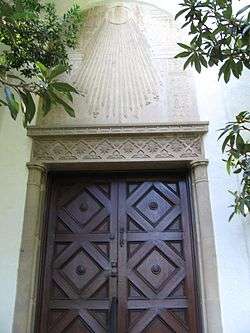Hale Solar Laboratory
The Hale Solar Laboratory is a historic astronomical observatory at 740 Holladay Road in Pasadena, Los Angeles County, California. Built in 1923, it was the laboratory of astronomer George Ellery Hale (1868-1938), a pioneering figure in the development of the discipline of astrophysics in the United States. The building, a distinctive blend of Mission Revival and Spanish Colonial Revival styles, was designated a National Historic Landmark in 1989.[2]
Hale Solar Laboratory | |
 The Hale Solar Laboratory entrance, with a bas relief by Lee Lawrie of the sun and its rays over the door, Pasadena, California | |
   | |
| Location | 740 Holladay Drive, Pasadena, California |
|---|---|
| Coordinates | 34°7′58.63″N 118°7′14.23″W |
| Area | less than one acre |
| Built | 1923 |
| Architect | Johnson, Kaufman & Coate |
| Architectural style | Mission Revival—Spanish Colonial Revival, Other. |
| NRHP reference No. | 86000103 |
| Significant dates | |
| Added to NRHP | January 23, 1986[1] |
| Designated NHL | December 20, 1989[2] |
Description
The Hale Solar Laboratory is located in a residential area south of the campus of the California Institute of Technology, on the east side of Holladay Road between Lombardy and Orlando Roads. It is set well back from the street, down a narrow tree-lined lane. It is a roughly T-shaped concrete structure, with a tile roof. The stem of the T consists of the telescope tower and Hale's library/office and living area, while the top portion of the T historically housed electrical and ventilation equipment. The main entrance is at the base of the tower, set in an arch above which is an incised bas-relief tribute to Akhenaten, the Egyptian pharaoh who worshipped the sun god Aten.[3]
History
The observatory was designed by Reginald Davis Johnson (1882 - 1952), Gordon Kaufmann (1888–1949), and Roland Coate (1890-1958) and was completed in 1923.[4] The site's landscape master plan and gardens were designed by Beatrix Farrand.
After retiring as director at the Mount Wilson Observatory, George Ellery Hale built the Hale Solar Laboratory as his office and workshop, pursuing his interest in the sun.[5][6] The observatory was where Hale refined the spectrohelioscope, making it possible to perform detailed observations of the surface of the sun. Hale's other wide-ranging contributions to the sciences include the founding of the International Astronomical Union, the Astrophysical Journal, and instrumental contributions to the founding of the California Institute of Technology.[3]
Landmark
The Hale Solar Laboratory was declared a National Historic Landmark in 1989.[2][3]
See also
References
- "National Register Information System". National Register of Historic Places. National Park Service. January 23, 2007.
- "Hale Solar Laboratory". National Historic Landmark summary listing. National Park Service. Archived from the original on 2007-11-14. Retrieved 2007-10-17.
- Harry Butowsky (May 1, 1989). "National Register of Historic Places Registration: Hale Solar Observatory" (pdf). National Park Service. Cite journal requires
|journal=(help) and Accompanying photos, exterior and interior, from 1926-1931. (574 KB) - Pacific Coast Architecture Database: Hale Solar Laboratory, Pasadena, CA
- "George Ellery Hale". Mount Wilson Observatory Association. Archived from the original on 2009-09-08. Retrieved 2010-04-11.
- "Hale Solar Laboratory". Astronomy and Astrophysics. U.S. National Park Service. Retrieved 2010-04-11.